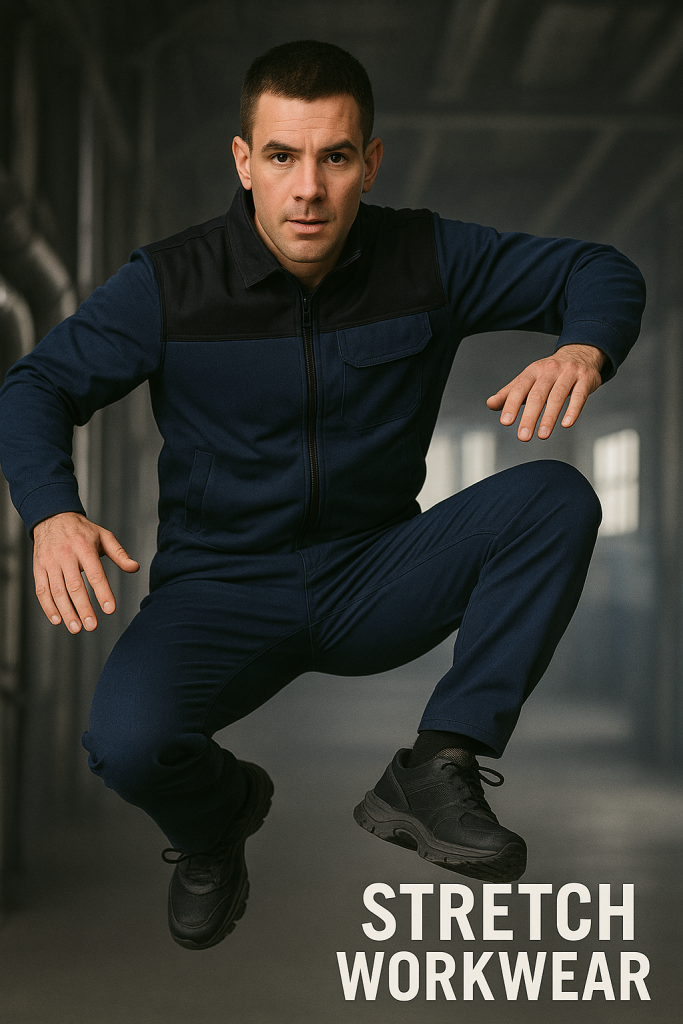The European and American workwear markets are shifting toward a new standard: elasticity plus durability and industrial wash resistance. EME stretch fiber, thanks to its spandex-free structure, superior elastic recovery, and heat resistance, has become a key alternative in stretch polyester-cotton workwear fabrics.
EME (Elastomultiester) is a multi-component polyester-based stretch fiber with over 15% elongation, offering excellent heat resistance, chlorine tolerance, and dimensional stability. It contains no spandex, making it ideal for high-temperature industrial laundry and long-wear use in workwear and uniforms requiring long-lasting elasticity and comfort.
Interested in whether EME stretch fabrics fit your brand? This article will cover technical principles, performance comparisons, real-world cases, and brand adoption insights.
What is EME fiber and how does it work?
EME, short for Elastomultiester, is a multi-component co-polyester fiber. A well-known example is LYCRA® T400®, developed by INVISTA. Unlike spandex, EME achieves elasticity through physical molecular structure: the dual-component polyester forms a spring-like shape that provides natural stretch and recovery.
Key benefits include:
- Built-in stretch with no spandex
- Enhanced breathability and moisture management
- Excellent thermal stability, supporting high-temperature washing and drying
- Chlorine resistance, ideal for repeated wear and industrial laundering
How does EME compare with elastane and elasterell?
For fabric buyers, understanding how fibers perform under different conditions is essential. Here’s a comparison of EME with elastane (spandex) and elasterell-P:
| Feature | EME (e.g. T400®) | Elastane (Spandex) | Elasterell-P |
|---|---|---|---|
| Stretch (%) | 10–20% (stable) | Up to 500% | 20–40% |
| Elastic recovery | Good (low fatigue) | Excellent | Moderate–Good |
| Industrial wash safe | ✅ Yes | ❌ Often degrades | ✅ Yes |
| Cost efficiency | Moderate | High | Moderate–High |
| Dyeing compatibility | ✅ Easy to dye | ❌ Requires separate dyeing | ✅ Good |
| Sustainability | ✅ Recyclable-friendly | ❌ Difficult to recycle | ✅ Recycled options |
Why EME is ideal for high-performance polyester-cotton workwear?
Leading global workwear brands like Dickies, Klopman, and Red Kap demand high-performance fabrics with:
- Tear resistance (e.g. ripstop construction)
- High-temperature washability (≥75°C)
- Durable elasticity
- Dry-touch, non-sticky feel
EME, with its spandex-free stretch structure, meets these needs effectively. In polyester-cotton blends like 43% polyester / 23% cotton / 34% EME, the fabric offers the perfect balance of structure, comfort, and technical reliability. It’s especially relevant for those searching for men EME stretch fiber workwear fabric—one of the fastest-growing search topics in B2B textile procurement.
Case Study: Our 43/23/34 polyester/cotton/EME ripstop fabric
One of our featured EME-based workwear fabrics has the following composition:
- Composition: 43% polyester / 23% cotton / 34% EME
- Weave: Ripstop
- Elongation: 15.7%
- Key features: Heat washable, tear-resistant, dry-touch, stable stretch
📌 Importantly, this is just one of many EME fabric options we offer. We also support full customization based on client specifications.
🧵 Typical procurement process:
- Customer provides specs (tech sheet or physical swatch)
- We review and offer a quotation
- If price is acceptable, we send similar samples for evaluation
- For more cautious clients, we offer lab dips or making samples (sampling requires a sample fee)
- Sample lead time is typically 30-40 days, same as bulk production
- Upon sample approval, bulk order is confirmed
- During bulk production, we run internal tests and send random bulk samples to the client
- Once bulk sample is approved, we arrange final shipment
This process ensures technical accuracy, traceability, and performance validation throughout the supply chain.
Which workwear brands are using EME fabrics today?
Well-known global workwear brands that have adopted EME-based fabrics include:
- Klopman (EU) – EME blends for industrial laundering applications
- Red Kap (USA) – Uses T400 in performance uniforms
- Dickies (Global) – Some lines incorporate EME as a spandex alternative
As more buyers move away from spandex due to wash limitations and recycling concerns, EME is gaining ground as the next-generation stretch solution.
Is EME fiber environmentally friendly?
While EME is a synthetic polyester, it does not contain spandex, which makes recycling more straightforward. Many recycling plants find non-spandex fabrics easier to process, reducing post-consumer textile waste. For brands seeking technical fabrics with a lower long-term environmental impact, EME-based materials offer a practical compromise between performance and recyclability.
Summary
EME stretch fiber is becoming a new industry standard for modern workwear. If you’re sourcing fabrics with stable elasticity, industrial wash resistance, and customization options, EME is an ideal choice. We offer tailored solutions, technical support, and lab-to-bulk quality control for workwear brands across Europe and North America.
📩 Contact us for samples and pricing

